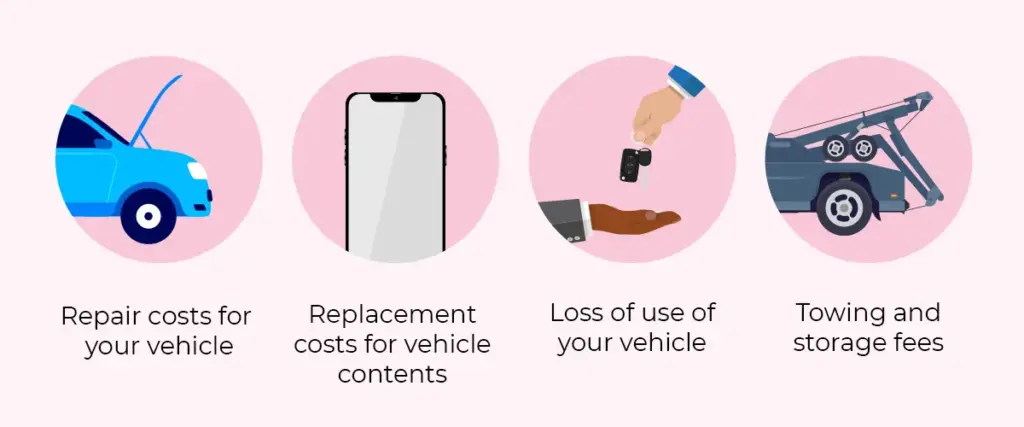On January 1, 2024, Ontario changed direct compensation-property damage (DC-PD) to optional coverage, allowing drivers to sign a form (called OPCF 49) to remove it from their policy.
DC-PD was mandatory as part of Ontario’s no-fault auto insurance system introduced in 1990. Making it optional was done to allow consumers more control over their coverage and provide an option to reduce costs. However, electing to remove DC-PD can prove more harm than good. Here’s why.
How does DC-PD work?
The cost of having DC-PD in your insurance policy varies by the vehicle, your demographics, how long you’ve been licensed, where you live, etc., but usually it averages between $400-$1,000/year. For most people, the biggest reason for opting out of DC–PD is to save this amount – but many may end up paying more than if they had kept DC–PD in their policy.
DC-PD covers you if you’re involved in an accident with another driver where you were either only partially at-fault or not at-fault. For example, someone rear-ended you at a red light. DC-PD would trigger and help cover:

- Repair costs for your vehicle
- Replacement costs for contents inside your vehicle
- Loss of use of your vehicle
- Towing and storage fees
If you sign OPCF 49 to remove DC-PD, you would not have coverage for any of these things in a not at-fault accident. Drivers may be severely financially impacted by vehicle damage if they’re hit by another driver or involved in a partially at-fault accident without this coverage.
What are the drawbacks of removing DC-PD?
For most drivers, we recommend not signing OPCF 49, especially if you want to cut costs. The endorsement may provide you with more choice, but it puts a lot of financial onus on you if you’re involved in a traffic collision – even one where you’re not at-fault.
Here are some of the main drawbacks of removing DC-PD from your policy:
Paying out-of-pocket
Without DC-PD coverage, you’d be left arranging and paying for the costs to repair your own vehicle, replace the contents left inside the vehicle, rent a car, and cover any additional fees pertaining to storage and towing.
Denied claims
As signing OPCF 49 removes DC-PD from your policy, you’re likelier to have not at-fault claims rejected as your policy will no longer meet your coverage needs.
Lengthy repair times
The length of time it takes to repair vehicles is longer nowadays because of chip shortages and supply chain issues. If you’re in an accident, you may need to find a temporary replacement for your car to get to work or do other daily tasks. DC-PD contains coverage for loss of use, but if you’ve removed it from your policy by signing OPCF 49, the price of a rental car is your own responsibility. According to Enterprise, Ontario currently has the longest average billed days (19.5) for rental vehicles where the driver is awaiting repairs. For rentals associated with total losses, the number is a bit higher at 24 days (about 3 and a half weeks) average.
This can rack up quickly in cost, especially when you consider that an Enterprise mid-sized SUV averages out to around $48.24 plus HST per day, and a pick-up truck will run about $45.74 plus HST. Non-Enterprise vehicle rentals will typically exceed $65/day.
Does signing OPCF 49 lower your insurance costs?
Yes, signing OPCF 49 and removing DC-PD may allow you to lower your premium by between 5% and 10%. But there’s more to it than that. Without DC-PD, you greatly risk being underinsured, and if money is already tight, OPCF 49 can put you in a worse situation than you would have been in had you not opted out of the coverage.
Talk with an insurance broker before electing to include OPCF 49 and opting out of DC-PD coverage.
Alternatives to removing DC-PD coverage from your auto insurance
We’re living in a cost-of-living crisis, and so it’s no wonder people are tempted by this new offering. Saving a few hundred dollars a year can be a huge opportunity for many but removing DC-PD may cost you more than you’d end up saving if you need to repair or replace your vehicle after a not at-fault accident. Here’s some alternative suggestions to removing DC-PD coverage from your auto insurance to help you save money:
Raise your DC-PD deductible
One alternative to removing DC-PD coverage altogether is to raise your deductible on it. DC-PD coverage automatically comes with no deductible, meaning in a not at-fault collision you’d pay nothing for the repairs to your car, but you can elect to raise that amount. Doing so will lower your rates, but it will also mean you’ll be responsible for a certain amount out-of-pocket if you’re involved in an accident. Choose this option with care.
Ask about bundling your home and auto insurance
Bundling your insurance is one of the easiest ways to save money on your coverage; in fact, what you save may equal or even exceed what you’d save by dropping DC-PD. If you have a home or renters policy, you can save hundreds of dollars on your auto insurance by insuring them through the same provider. Talk with one of our insurance brokers for more information about this option.
Try usage-based insurance
Usage-based insurance is a program through which you agree to have your driving behaviours tracked. Good driving behaviour can result in savings, and many programs will offer you an initial 5%-10% discount for just signing up. Some programs can save you up to 30% on your insurance.
It’s important to look at all your options before opting out of DC-PD
If you’re considering OPCF 49 to remove DC-PD from your policy, give us a call. Mitch works with over 70 of Canada’s top insurers and can help find you an affordable alternative without needing to sacrifice much-needed coverage.
Looking for car insurance?
Speak with a Mitch Insurance broker today to get a quote on Ontario auto insurance.
Call now
1-800-731-2228







